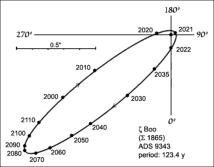Visual Binaries are two stars as seen as separate points of light. The orbital period of the stars is generally very long, and the
observer must be very patient, for several decades of observations are generally required. Since the discovery of binary stars by
William Herschel over two hundred years ago, the orbits of hundreds of these systems have been cataloged. One of the most
famous visual binaries are the two stars Alcor and Mizar in the handle of the Big Dipper. Another star system that was discovered
early in the twentieth century is Sirius.
Here is a film from many years ago that describes one particular binary star system in the constellation of Ursa Major. Visual binaries are ones for
which both stars can be seen separately. These systems tend to be relatively close to the Sun. That’s why we can see two separate stars. The orbits
themselves must be very large, resulting in orbital periods that may be hundreds of years. These binary stars have been cataloged by Otto Struve
and Robert Aiken. If you click on the orbit image above and to the left, you will see the stars’ catalog designations.
The brighter of the two stars is given the designation as the A component, and the dimmer one would be B. The visual binary most familiar to us is
Alpha Centauri, which is actually two stars which are not unlike the Sun. A favorite of mine is Gamma Leonis also known as Algieba. Fans of the
University of Michigan might like to observe Albireo.
Looking for a particular star? Find it here!



Visual Binary Stars


























